
Softball is a game similar to baseball played with a larger ball on a smaller field, with only underhand pitches permitted. Softball is played competitively at club levels, the college level, and the professional level. The game was first created in 1887 in Chicago by George Hancock.
In baseball, a sacrifice bunt is a batter's act of deliberately bunting the ball, before there are two outs, in a manner that allows a baserunner to advance to another base. The batter is almost always put out, and hence sacrificed, but sometimes reaches base on an error or fielder's choice. In that situation, if runners still advance bases, it is still scored a sacrifice bunt instead of the error or the fielder's choice. Sometimes the batter may safely reach base by simply outrunning the throw to first; this is not scored as a sacrifice bunt but rather a single.
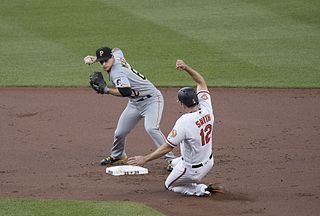
In baseball and softball, a double play is the act of making two outs during the same continuous play. Double plays can occur any time there is at least one baserunner and fewer than two outs.

Catcher is a position in baseball and softball. When a batter takes their turn to hit, the catcher crouches behind home plate, in front of the (home) umpire, and receives the ball from the pitcher. In addition to this primary duty, the catcher is also called upon to master many other skills in order to field the position well. The role of the catcher is similar to that of the wicket-keeper in cricket.

A first baseman, abbreviated 1B, is the player on a baseball or softball team who fields the area nearest first base, the first of four bases a baserunner must touch in succession to score a run. The first baseman is responsible for the majority of plays made at that base. In the numbering system used to record defensive plays, the first baseman is assigned the number 3.
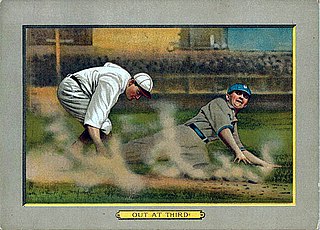
In baseball, an out occurs when the umpire rules a batter or baserunner out. When a batter or runner is out, they lose their ability to score a run and must return to the dugout until their next turn at bat. When three outs are recorded in a half-inning, the batting team's turn expires.

Throughout the history of baseball the rules have frequently changed as the game has continued to evolve. The rules of baseball can vary slightly from league to league, with there being dozens of leagues worldwide. A few common rules most professional leagues have in common is that 4 balls is a Base on balls, 3 strikes is a strikeout and 3 outs ends a half inning. One example of differing rules in professional leagues is in Major League Baseball a pitch clock is in place to speed up the pace of the game by forcing pitchers to pitch in a 15-20 second window, where in the Nippon Professional Baseball League no such rule exists.

A baseball field, also called a ball field or baseball diamond, is the field upon which the game of baseball is played. The term can also be used as a metonym for a baseball park. The term sandlot is sometimes used, although this usually refers to less organized venues for activities like sandlot ball.
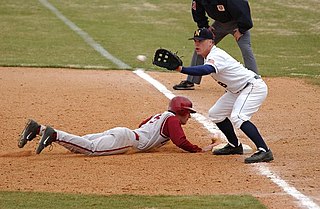
In baseball, part of the infielders' and pitcher's jobs is to cover bases. That is, they stand next to a base in anticipation of receiving the ball thrown from another fielder, so that they may make a play on an opposing baserunner who is approaching that base. On a force play, the fielder covering the base stands with one foot on that base.
Baseball and cricket are the best-known members of a family of related bat-and-ball games. Both have fields that are 400 feet (120 m) or more in diameter between their furthest endpoints, offensive players who can hit a thrown/"bowled" ball out of the field and run between safe areas to score runs (points) at the risk of being gotten out, and have a major game format lasting about 3 hours.
In baseball, interference occurs in situations in which a person illegally changes the course of play from what is expected. Interference might be committed by players on the offense, players not currently in the game, catchers, umpires, or spectators. Each type of interference is covered differently by the rules.

In the sports of baseball and softball, a batted ball is a pitch that has been contacted by the batter's bat. Batted balls are either fair or foul, and can be characterized as a fly ball, pop-up, line drive, or ground ball. In baseball, a foul ball counts as a strike against the batter, unless there are already two strikes on the batter, with special rules applying to foul tips and foul bunts. Fly balls are those hit in an arcing manner, with pop-ups being a subset of foul balls that do not travel far. Line drives are batted balls hit on a straight line trajectory, while ground balls are hit at a low trajectory, contact the ground shortly after being hit, and then either roll or bounce. Batted balls, especially line drives, can present a hazard to players, umpires, and spectators, as people have been seriously injured or killed after being struck by batted balls.
A hit and run is a high risk, high reward offensive strategy used in baseball. It uses a stolen base attempt to try to place the defending infielders out of position for an attempted base hit.

Baseball scorekeeping is the practice of recording the details of a baseball game as it unfolds. Professional baseball leagues hire official scorers to keep an official record of each game, but many fans keep score as well for their own enjoyment. Scorekeeping is usually done on a printed scorecard and, while official scorers must adhere precisely to one of the few different scorekeeping notations, most fans exercise some amount of creativity and adopt their own symbols and styles.
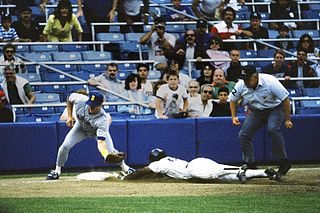
In the sport of baseball, small ball is an informal term for an offensive strategy in which the batting team emphasizes placing runners on base and then advancing them into scoring position for a run in a deliberate, methodical way. This strategy places a high value on individual runs and attempts to score them without requiring extra base hits, or sometimes without base hits at all, instead using bases on balls, stolen bases, sacrifice bunt or sacrifice fly balls, the hit-and-run play, and aggressive baserunning with such plays as the contact play. A commonly used term for a run produced playing small ball is a "manufactured run". This style of play was more often found in National League game situations than in the American League due in large part to the absence of the designated hitter in the National League until the universal adoption of the Designated Hitter.
This is an alphabetical list of selected unofficial and specialized terms, phrases, and other jargon used in baseball, along with their definitions, including illustrative examples for many entries.
The wheel play is a defensive strategy in baseball designed to defend against a sacrifice bunt. The play's name derives from the wheel-like rotation of the infielders.
Slap bunting is an offensive baseball and softball technique wherein the batter attempts "to hit the ball to a place on the infield that's farthest from the place where the out needs to be made".
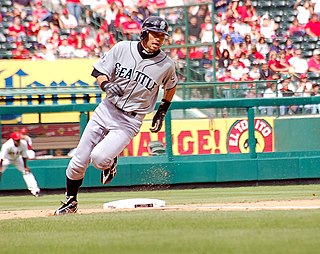
In baseball, base running is the act of running from base to base, performed by members of the team at bat.














